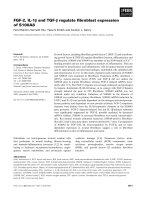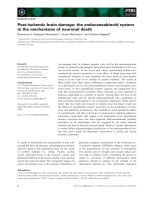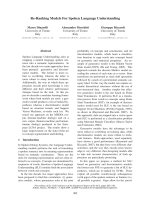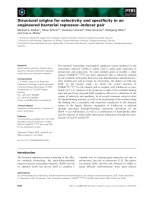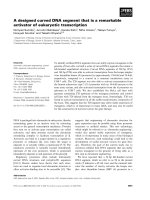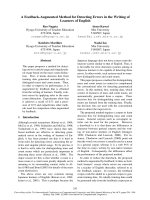báo cáo khoa học: "Population crash, population flush and genetic variability in cage populations of Drosophila melanogaster" pot
Bạn đang xem bản rút gọn của tài liệu. Xem và tải ngay bản đầy đủ của tài liệu tại đây (599.67 KB, 11 trang )
Population
crash,
population
flush
and
genetic
variability
in
cage
populations
of
Drosophila
melanogaster
F.A.
LINTS
M.
BOURGOIS
Laboratoire
de
Ge
netique,
Universite
de
Louvain
2,
place
Croix-du-Sud,
B
1348
Louvain-la-Neuve
(Belgium)
Summary
A
large
increase
in
the
total
phenotypic
variance
of
thorax
size
was
observed
in
a
cage
population
of
Drosophila
melanogaster,
maintained
at
28
°C,
a
few
months
after
it
had
been
the
victim
of
a
naturally
occuring
population
crash,
the
number
of
individuals
in
the
population
having,
at
a
given
moment,
been
reduced
to
half
a
dozen.
In
order
to
ascertain
whether
that
increase
in
total
phenotypic
variance
was
due
to
an
increase
in
environmental
or
in
genetic
variance
that
population
was
submitted,
together
with
five
other
normally
developing
cage
populations,
to
a
selection
programme
for
high
and
low
bristle
number.
The
additive
genetic
variance
of
these
various
populations
was
thereafter
estimated.
The
additive
genetic
variance
of
the
28
°C
cage
population,
victim of
a
popu-
lation
crash,
was
found
to
be
highly
significantly
larger
than
all
the
other
ones.
The
consequences
of
that
unexpected
observation
on
the
theories
of
evolution
are
discussed.
It
is
argued
that
that
result
confirms
some
of
the
predictions
of
the
genetic
revolution
(genetic
transilience)
hypothesis
of
speciation.
Key
words :
Drosophila
melanogaster,
cage
populations,
genetic
variance,
speciation,
genetic
revolution
hypothesis,
sternopleural
bristles.
Résumé
Changements
d’effectifs
et
variabilité
génétique
dans
des
cages
à
population
chez
Drosophila
melanogaster
Un
accroissement
important
de
la
variance
phénotypique
totale
de
la
taille
thoracique
a
été
observé
dans
une
cage
à
population
de
Drosophila
melanogaster
quelques
mois
après
que
cette
population
ait
été
victime
d’une
réduction
drastique
et
naturelle
du
nombre
d’individus
qui
la
composait,
ce
nombre
ayant
été
réduit
à
environ
une
demi-douzaine
d’individus.
Cet
accroissement
brutal
de
la
variance
phénotypique
totale
pouvait
être
dû
à
un
accroissement,
soit
de
la
variance
due
à
l’environnement,
soit
de
la
variance
génétique.
De
manière
à
résoudre
cette
alternative,
cette
population
a
été
soumise
à
une
sélection
bidirectionnelle
pour
le
nombre
de
soies
sternopleurales
de
concert
avec
cinq
autres
populations
qui
s’étaient
développées
normalement
dans
des
cages
à
population
dans
diverses
conditions
d’environnement.
Il
a
dès
lors
été
possible
d’estimer
la
variance
génétique
additive
de
ces
diverses
populations.
Il
est
montré
que
la
variance
génétique
additive
de
la
popu-
lation
victime
d’une
réduction
drastique
de
ses
effectifs
est
de
loin
supérieure
à
celle
de
toutes
les
autres
populations
observées.
Les
conséquences
de
cette
observation
inattendue
sur
les
théories
de
l’évolution
sont
débattues.
Les
auteurs
estiment
que
ce
résultat
confirme
un
certain
nombre
des
prédictions
émises
par
les
théoriciens
de
l’hypothèse
sur
la
spéciation
dite
hypothèse
de
la
révolution
génétique
(hypothèse
de
la
transilience
génétique).
Mots
clés :
Drosophila
melanogaster,
cages
à
population,
variance
génétigue,
spéciation,
hypothèse
de
la
révolution
génétique,
soies
sternopleurales.
1.
Introduction
It
has
generally
been
assumed
that
speciation
is
the
result
of
a
gradual
and
slow
genetic
divergence
brought
about
by
different
selection
pressures
acting
on
ecologically
isolated
populations.
For
some
time
however
a
few
authors
(C
ARSON
,
1971,
1975 ;
T
EMPLETON
,
1980
’
a;
J
ONES
,
1981}
have
been
claiming
that
speciation
could
also
be
due
to
a
so-called
« genetic
revolution
caused
by
random
processes
acting
on
very
small
isolated
populations.
That
idea
of
genetic
revolution
originates
from
the
so-called
«
founder’s
principle
proposed
by
M
AYR
as
early
as
1942.
M
AYR
defines
it
as
referring
to
« the
establishment
of
a
new
population
by
a
few
original
founders
which
carry
only
a
small
fraction
of
the
total
genetic
variation
of
the
parental
popu-
lation ».
M
AYR
’S
theory
of
the
founder’s
principle
and
of
the
ensuing
genetic
revolution
thus
admits
that
the
few
original
founders
of
a
new
population
possess
only
a
part
of
the
genetic
variability
to
be
found
in
the
population
from
which
the
founders
originated.
Afterwards
that
reduced
genetic
variability
may
be
even
further
reduced
because
of
the
consequences
of
the
random
drift
which
is
a
direct
function
of
the
reduced
size
of
a
population.
More
specifically
M
AYR
(1954)
argued
that
the
founder
effect
and
its
associated
inbreeding
would
affect
« all
loci
at
once».
The
question
then
arises
how
a
new,
large,
normal
and
eventually
diverging
population
may
spring
up
from
a
single
or
a
few
founder
individuals.
M
AYR
(1954)
has
suggested
that
as
a
result
of
the
increased
frequency
of
homozygotes
in
the
founder
population
selection
against
certain
genes
will
increase.
The
«
genetic
envi-
ronment
» will
be
changed
so
as
to
modify
radically
the
selective
value
of
a
large
number
of
loci
up
to
the
point
where
the
system
reaches
a
new
state
of
equilibrium.
In
other
words,
the
hypothesis
holds
that
if
colonization
is
accomplished
by
a
single
or
a
small
number
of
founders
the
breaks
in
the
gene
pool
may
be
significant
enough
to
result
in
a
drastic
reconditioning
of
the
gene
pool
of
the
new
colony
resulting
in
a
genetic
revolution.
More
or
less
in
the
same
line
of
thinking
C
ARSON
(1971)
believes
that
« when
a
population
derived
from
a
single
founder
expands,
the
loss
of
genetic
variability
expected
through
random
drift
can
be
expected
to
be
temporary
and
can
be
compen-
sated
for
by
new
mutations
».
J
ONES
(1981),
reviewing
the
models
of
speciation,
ascribes
the
renewal
of
genetic
variability
to
the
fact
that
by
invading
previously
unexploited
ecological
niches
the
founders
may
undergo
an
enormous
increase
in
number,
the
popu-
lation
flush.
The
consequence
of
that
flush
is
a
relaxation
of
selection
against
deviant
individuals
which
will
further
favour
the
success
of
the
genetic
revolution.
T
EMPLETON
(1980
a
and
b)
admits
that
a
founder
effect
can
induce
rapid
spe-
ciation
but
does
not
believe
that
the
speciation
is
mediated
by
extensive
changes
throughout
the
genome
(M
AYR
’S
genetic
revolution).
His
theory,
which
he
prefers
to
call
genetic
transilience
rather
than
genetic
revolution,
is
indeed
based
upon
just
the
opposite
assumption :
A
genetic
transilience
does
not
shake-up
the
whole
genome ;
rather
it
is
confined
principally
to
a
polygenic
system
strongly
affecting
fitness
that
is
characterized
by
having
a
handful
of
major
genes
with
strong
epistatic
interactions
with
several
minor
genes
(T
EMPLETON
,
1980
a).
Noteworthy
in
T
EMPLETON
’S
theory
is
the
fact that
if
there
are
indeed
a
few
major
genes
implied
in
the
genetic
transilience
then
the
stochastic
effects
of
the
founder
event
cannot
be
ignored.
In
other
words
not
all
founder
events
-
and
indeed
perhaps
only
a
minority
of
these
events
-
will
lead
to
speciation
via
the
genetic
transilience
model
(T
EMPLETON
,
1980 b).
According
to
T
EMPLETON
(1980 b)
for
genetic
transilience
to
occur
the
changes
in
the
genetic
selection
environment
must
be
so
drastic
that
a
selection
bottleneck
is
engendered ;
this
may
occur
if
the
change
in
the
effective
sizes
of
the
ancestor
and
the
founder
populations
is
large.
The
chance
of
the
founder
population
to
survive
and
to
respond
to
that
selection
bottleneck
will
then
depend
upon
the
level
of
genetic
variability
present
in
the
founder
population.
In
that
respect
RosE
(1982)
has
suggested
that
genetic
systems
characterized
by
much
epistasis
and
pleiotropy
can
maintain
large
amounts
of
genetic
variation ;
he
further
argued
that
when
such
systems
are
dirsupted
-
as
they
could
be
in
T
EMPLETON
’S
model,
first
through
the
founder
effect,
then
by
the
effects
of
recombination
during
the
population
flush
-
such
systems
can
release
large
amounts
of
additive
genetic
variance.
Despite
these
theoretical
speculations,
there
are
still
questions
which
have
not
yet
received
a
proper
experimental
answer.
For
instance,
there
is
no
experimental
evidence
about
the
increase,
decrease
or
stability
of
the
genetic
variability
in
a
population
issued
from
a
small
founder
population.
Nor
about
the
environmental
conditions
which
may
eventually
further
that
genetic
variability.
We
were
able,
a
few
months
after
their
foundation,
to
estimate and
compare
the
genetic
variability
of
various
cage
populations,
maintained
for
a
few months
at
different
temperatures
and
issued
either
from
a
small
or
a
large
number
of
founder
individuals.
Although
in
a
preliminary
stage,
these
observations
confirm
some
of
the
predictions
of
the
genetic
revolution
hypothesis
and
suggest
that
adverse
environmental
conditions
may
further
genetic
variability
in
a
very
short
time.
II.
Material
and
methods
Two
strains
of
Drosophila
melanogaster
were
used :
the
wild
laboratory
strain,
Oregon,
previously
maintained
in
our
laboratory,
at
25
°C,
for
at
least
fifteen
years
and
the
Bonlez
strain,
started
from
flies
captured
in
the
wild
(in
Belgium)
fourteen
months
before
the
experiments.
In
January
1979
three
times
60
pairs
of
flies
of
the
Oregon
strain
were
placed
in
population
cages
at
21°,
25°
and
29 °C,
respectively.
The
21
and
25
°C
populations
expanded
rapidly
in
number
and
attained,
after
a
few
weeks,
a
stable
population
size
of
about
1
000
to
1
500
flies.
The
29
°C
popu-
lation
eventually
died
out.
An
attempt
was
then
made
at
28
°C ;
the
population
size
remained
very
low
for
a
few
months
and,
in
September
1979,
was
even
low
as
half
a
dozen
flies ;
afterwards,
in
a
few
weeks,
it
increased
rapidly
in
number
and
became
stabilized.
Concerning
the
Bonlez
strain
40
inseminated
females
of
Drosophila
melanogaster
were
captured
in
Bonlez
(Belgium)
in
July
1979 ;
they
were
allowed
to
multiply
and
their
offspring
were
divided
in
three
groups
which
were
transferred
in
half
pint
milk
bottles
at
21°,
25°
and
28 °C.
III.
Results
In
April
1980,
from
the
eggs
collected
in
the
three
population
cages
(Oregon
populations)
and
in
the
three
culture
bottles
(Bonlez
populations),
the
thorax
size
of
samples
of
50
females
and
50
males
was
measured
and
the
mean
size
and
the
variance
of
the
size
were
calculated
(tabl.
1).
).
Two
important
facts
emerge
from
these
results.
First :
the
variance
of
the
size
is,
on
average,
larger
in
the
Bonlez
strain
than
in
the
Oregon
strain;
this,
most
pro-
bably,
reflects
the
past
history
of
these
two
strains,
Oregon
having
been
adapted
for
fifteen
years
at
a
constant
temperature
of
25
°C
and
Bonlez
being
a
freshly
captured
wild
strain
.Second :
the
variance
of
the
thorax
size
of
the
28
°C
and
21
°C
Oregon
populations
is
significantly
larger
than
the
variance
of
the
25
°C
population.
(It
must
be
reminded
that
the
original
Oregon
strain
had
been
maintained
at
25
°C
for
at
least
fifteen
years).
The
higher
variability
of
the
28
°C
and
21
°C
Oregon
populations
points
either
to
a
higher
genetic
or
to
a
higher
phenotypic
variability.
In
order
to
discriminate
between
these
two
possibilities
a
two-way
selection
experiment
was
undertaken.
Indeed
such
an
experiment
allows
one
to
estimate,
for
a
particular
trait,
the
additive
genetic
variance
present
in
the
population.
The
trait
chosen
was
sternopleural
bristle
number :
the
heritability
of
that
trait
is,
in
general,
quite
large
and,
as
shown
by
some
preli-
minary
measurements
(tabl.
2)
the
phenotypic
expression
of
the
character
is
almost
insensitive
to
the
effects
of
developmental
temperature.
The
characteristics
of
the
Oregon
and
Bonlez
populations
before
the
selection
experiment
began
are
given
in
table
2,
which
shows
that
the
variance
of
bristle
number
of
the
28
°C
Oregon
population
is
remarkably
high ;
it
is
significantly
larger
(P
<
0.001
or
<
0.01!)
than
all
the
other
variances
except
the
one
of
the
28 °C
Bonlez
population.
The
variance
of
bristle
number
of
the
Oregon
21
°C
population
is
also
significantly
higher
than
that
of
the
Oregon
25
°C
population.
In
the
six
populations
where
selection
for
bristle
number
was
made,
48
females
and
48
males
were
measured
for
sternopleural
bristle
number,
at
each
generation,
both
in
a
high
and
a
low
line.
12
lines
were
thus
created.
The
12
females
and
the
12
males
with
the
highest
and
lowest
bristle
numbers
were
kept
for
reproduction.
The
selection
was
continued
for
four
generations.
The
results
of
that
selection
experiment
are
given
in
figure
1
and
tables
3
and
4 :
the
cumulated
selection
differentials
and
the
cumulated
responses
are
given
in
table
3 ;
the
realised
heritabilities
(see
fig.
1
B)
and
the
estimated
additive
genetic
variances
for
the
six
populations
tested
are
given
in
table
4.
The
selection
differentials
are
not
very
different
from
one
population
to
the
other ;
they
are
however
higher
at
28
°C
than
at
the
other
temperatures,
especially
for
the
Oregon
strain.
The
cumulated
responses
are,
on
the
average,
smaller
for
the
Bonlez
strain
than
for
the
Oregon
strain.
In
the
Oregon
strain
the
cumulated
response
at
25
°C
is
small
-
of
the
same
order
of
magnitude
as
the
responses
of
the
Bonlez
strain
- ;
it
is
larger
at
21
°C
and
much
larger
at
28
°C
-
more
than
twice
the
response
at
25
°C
(The
selections
were
made
at
21°,
25°
and
28 °C,
i.e.
at
the
temperatures
at
which
the
populations
were
kept
during
the
preceding
period
of
time.)
(The
responses
and
selection
differentials
in
the
high
and
low
lines
being
symmetrical
in
all
the
populations
observed,
the
figures
given
are
means.)
realised
heritabilities
(i.e.
the
coefficient
of
regression
of
the
cumulated
response
on
the
cumulated
selection
differential)
in
the
three
Bonlez
populations
are
similar.
In
the
Oregon
strain,
for
the
25
°C
population,
it
is
of
the
same
order
of
magnitude
as
the
ones
of
the
Bonlez
strain ;
it
is
however
higher
in
the
21
°C
popu-
lation
and
maximal
in
the
28
°C
population.
The
realised
heritabilities
of
Oregon
28
°C
and
Oregon
21
°C
are
significantly
larger
than
the
one
of
Oregon
25
°C.
Finally
the
additive
genetic
variance,
which
may
be
estimated
by
the
product
of
the
realised
heritability
and
of
the
total
variance
present
in
the
base
population
is
the
largest
in
the
28
°C
Oregon
population ;
it
is
in
fact
almost
twice
as
large
as
the
nearest
value
observed
in
the
21
°C
population.
These
results
indicate
that
the
high
variabilities
of
the
28
°C
and
21
°C
Oregon
populations
are,
at
least
partly,
due
to
a
high
genetic
variability
present
in
these
populations.
The
genetic
variability
of
the
28
&dquo;C
population,
issued
from
a
very
small
number
of
founder
individuals,
and
submitted
to
highly
adverse
environmental
condi-
tions
is
the
largest
of
the
six
populations
tested.
The
variability
of
the
21
°C
Oregon
population,
submitted
to
conditions
radically
different
from
those
that
the
original
Oregon
strain
had
been
submitted
to
for
fifteen
years,
is
also
very
high.
IV.
Discussion
The
appearance
of
a
genetic
novelty,
i.e.
a
new
species,
an
incipient
species
or
a
population
diverging
from
the
population
from
which
it
originated,
has
been
attri-
buted
either
to
natural
selection
(D
OWDESWELL
&
FORD,
1952,
1953 ;
FORD,
1954),
to
random
drift
(D
OBZHANSKY
,
1941)
or
to
a
mixture
of
both
these
factors
(DOBZHANSKY
&
PAVLOVSKY,
1957).
These
different
opinions
on
the
genetic
evolution
of
populations
derived
from
a
few
founders
mainly
take
into
account
the
genetic
variability
which
is
originally
present
in
the
founders
and
which,
until
recently,
has
been
believed
to
be
smaller
than
the
genetic
variability
present
in
the
population
from
which
the
founders
origi-
nated.
However,
the
emergence
of
a
well
adapted
species
or
population
with
new
genetic
characteristics
from
a
small
founder
population
implies
both
an
important
genetic
variability,
on
which
natural
selection
may
act,
and
certain
genetic
novelties,
which
are
a
source
of
new
qualities.
That
genetic
variability
may
stem,
either
from
a
relaxed
or
modified
selection
pressure
(C
ARSON
,
1971 ;
J
ONES
,
1981),
or,
as
sugges-
ted
by
recent
experimental
evidence
and
theoretical
speculations
(A
NNEST
&
T
EM
-
PLETON
,
1978 ;
T
EMPLETON
,
1980
a
and
b ;
RosE,
1982)
from
a
creative
disruption
of
the
genetic
system
of
the
founder
individuals.
Does
such
variability
exist ?
As
far
as
we
know,
and
curiously
enough,
no
one
has
searched
for
it.
In
fact
at
the
root
of
most
speculations
are
observations
either
of
divergent
-
not
diverging !
-
populations
or
of
new
species
(see,
for
instance,
the
observations
of
C
ARSON
’S
school
on
the
Drosophila
fauna
of the
Hawaiian
archi-
pelago.
C
ARSON
&
K
ANESHIRO
,
1976;
K
ANESHIRO
,
1980).
Exemplary
too
are
the
efforts
made
to
show
the
existence
of
sexual
isolation
in
experimental
populations
(see,
for
instance,
in
recent
years,
PO
WELL
,
1978 ;
T
EMPLETON
,
1979 ;
A
HE
ARN,
1980).
Although
it
appears
conceivable
that
in
a
large
population
the
appearance
of
sexual
isolation
may
be
at
the
origin
of
evolutionary
divergence,
it
appears
highly
probable
that
in
the
case
of
diverging
isolated
populations,
issued
from
small
founder
popu-
lations,
genetic
divergence
does
not
need
to
start
with
sexual
isolation.
This
last
point
was
clearly
shown
by
the
study
of
genetic
differentiation
during
the
speciation
process
in
the
Drosophila
willistoni
group
of
species
(A
YALA
et
al.,
1974).
And
indeed
the
Oregon
and
Bonlez
populations
were
tested
for
sexual
isolation ;
no
sign
of
it
could
be
brought
to
the
fore.
The
present
experiments
show
that
very
soon
after
a
population
has
suffered
a
severe
bottleneck
the
resulting
new
population
(Oregon
28
°C)
displays
a
very
high
genetic
variability,
larger
than
the
one
present
in
the
original
population
(Oregon
25
’C).
Where
does
that
variability
come
from ?
It
is
not
impossible
that
mutant
individuals,
which,
in
normal
breeding
conditions,
would
normally
be
eliminated
by
natural
selection,
may
survive
during
the
period
of
population
expansion
which
follows
the
bottleneck.
M
UKAI
(1964)
has
estimated
that,
in
Drosophila,
at
least
5
p.
100,
and
maybe
35
p.
100,
of
the
gametes
carry
a
new
mutation.
An
alternative
possibility
is
that
that
variability
was
present
among
the
founder
individuals
and
that
it
was
very
rapidly
released,
according
to
the
suggestions
made
by
T
EMPLETON
(1980 b)
and
by
ROSE
(1982),
first
through
the
founder
effect
and
then
through
the
effects
of
genetic
recombination
occuring
during
the
population
flush.
The
present
evidence
does
however
not
discriminate
between
these
alternatives.
Now
all
the
variations
in
genetic
variability
disclosed
in
our
experiments
cannot
be
explained
by
the
effects
of
a
bottleneck
followed
by
a
population
flush.
If
it
were
Oregon
21
’
°C
should
not
be
more
variable
than
Oregon
25
°C,
since
none
of
these
two
populations
suffered
a
bottleneck.
Yet
Oregon
21 °C
is
almost
as
variable
as
Oregon
28
°C
and,
anyway,
much
more
than
Oregon
25
°C.
For
the
last
fifteen
years
the
Oregon
strain
was
maintained,
at
25
°C,
in
environmental
conditions
that
caused
severe
natural
selection.
The
population
cage
breeding,
at
25
°C,
should
not
sensibly
affect
the
well-adapted
Oregon
25 &dquo;C
population.
On
the
other
hand
the
modification
of
the
ecological
conditions
caused
by
the
sudden
transfer
from
25
°C
to
21
°C
may
eventually
lead
to
the
generation
of
new
genetic
variance,
for
example,
by
a
modification
of
the
selective
values
of
many
genes.
The
genetic
variabilities
of
the
three
Bonlez
populations,
although
similar,
increase
slightly
between
21
&dquo;C
and
28
&dquo;C.
It
may
be
recalled
that
these
three
popu-
lations
directly
derive
from
a
wild
population,
which,
by
definition,
is
submitted
to
variable
ecological
conditions.
In
such
a
population
the
genetic
variability
must
be
important
and
the
selective
values
must
be
variable.
Considering
the
Bonlez
data
in
the
light
of
the
present
results,
it
is
however
not
surprising
to
notice
that
the
genetic
variability
is
the
largest
at
28
&dquo;C,
the
environment
which
is
the
most
unusual
to
a
wild
strain.
The
present
data
show
that
a
population
reduced
to
a
very
small
number
of
individuals
either
can
rapidly
restore
or
can
maintain
a
great
deal
of
genetic
variability.
They
also
show
that
such
a
population
can
diverge
genetically
from
the
population
it
was
started
from.
They
finally
show
that
adverse
environmental
conditions
may
also
lead
to
the
generation
of
an
important
genetic
variability.
It
must
be
stressed
that
the
existence
of
a
large
amount
of
genetic
variability
in
the
population
which
had
suffered
a
severe
bottleneck
was
observed
less
than
seven
months
after
the
bottleneck
occured,
a
rather
surprising
and
at
least
unusual
observation.
In
that
respect
it
may
however
be
reminded
that
most,
if
not
all,
studies
looking
at
differences
arising
in
population
cages
of
identical
origin
submitted
to
various
environmental
conditions
have
been
started
a
few
years
after
isolation
(see,
for
instance,
E
HRMAN
,
1964 ;
MO
URA
D,
1965 ;
ANDERSON,
1966).
It
is
clear
that
the
present
observations
and
measurements
should
be
multiplied.
They
should
also
be
done
just
after
the
bottleneck,
during
the
flush
phase,
and
at
regular
intervals
during
the
phase
of
stability.
Yet
it
will
be
a
difficult
task
to
multiply
the
present
observations.
Indeed
in
a
population
cage
a
naturally
occuring
bottleneck
is
not
an
ordinary
phenomenon.
Creating
a
bottleneck
by
starting
a
population
cage
with
a
very
few
randomly
choosen
individuals
will
probably
not
mimic
a
naturally
occuring
bottleneck
where
the
few
surviving
individuals
most
probably
survive
because
of
their
exceptional
phenotype.
Now,
suppose
that
bottlenecks
can
be
multiplied.
If,
in
all
cases
the
founders
individuals
survive
and
a
large
genetic
variability
is
observed
during
the
phase
of
stability,
this
could
be
used
as
an
argument
in
favour
of
the
genetic
revolution
hypothesis
of
speciation.
On
the
opposite
if
only
a
(non
definable ?)
fraction
of
the
bottleneck
populations
survive
this
could,
eventually,
be
used
as
an
argument
in
favour
of
the
genetic
transilience
theory
of
speciation.
Furthermore
it
is
not
impossible
that
the
time
of
onset
of
the
increase
in
genetic
variability,
as
observed
in
the
present
experiment,
may
be
different
as
a
function
of the
reality
of
the
one
or
the
other
hypothesis.
May
we
suggest
that
the
tenants
of
both
these
hypotheses
specify
their
views
on
these
questions !
Received
February
11,
1983.
Accepted
July
29,
1983.
Acknowledgements
This
work
was
supported
by
the
U.S.
N.LH.
AG
02087
grant
to
F.A.L.
M.B.
was
a
fellow
of
the
LR.S.LA.
This
paper
was
written
at
the
Department
of
Agricultural
Botany
of
the
University
College
of
Wales
at
Aberystwyth
where
one
of
us
(F.A.L.),
at
the
kind
invitation
of
Professor
H.
R
EES
,
was
appointed
Visiting
Professorial
Fellow.
Many
thanks
are
due
to
D’
N.
J
ONES
(Aberystwyth)
for
a
critical
reading
of
the
manuscript.
References
A
HEARN
J.N.,
1980.
Evolution
of
behavioral
reproductive
isolation
in
a
laboratory
stock
of
Drosophila
silvestris.
Experientia,
36,
63-64.
A
NDERSON
W.W.,
1966.
Genetic
divergence
in
M.
Vetukhiv’s
experimental
populations
of
Drosophila
pseudoobscura.
3.
Divergence
in
body
size.
Genet. Res.,
7,
255-266.
A
NNEST
J.L.,
T
EMPLET
ON
A.R.,
1978.
Genetic
recombination
and
clonal
selection
in
Drosophila
mercatorum.
Genetics,
89,
193-210.
A
YALA
F.J.,
T
RACEY
M.L.,
B
ARR
L.G.,
McDoN
ALD
J.F.,
P
EREZ-S
ALAS
S.,
1974.
Genetic
variation
in
natural
populations
of
five
Drosophila
species
and
the
hypothesis
of
the
selective
neutrality
of
protein
polymorphism.
Genetics,
77,
343-384.
C
ARSON
H.L.,
1971.
Speciation
and
the
founder
principle.
Stadler
Genet.
Symp.,
3,
51-70.
C
ARSON
H.L.,
1975.
The
genetics
of
speciation
at
the
diploid
level.
Am.
Nat.,
109,
83-92.
C
ARSON
H.L.,
K
ANESHIRO
K.Y.,
1976.
Drosophila
of
Hawaii :
systematics
and
ecological
genetics.
Annu.
Rev.
Ecol.,
7,
311-345.
D
OBZHANSKY
T.,
1941.
Genetics
and
the
Origin
of
Species.
Columbia
University
Press.
New
York.
DoszHnrrsxY
T.,
P
AVLOVSKY
0.,
1957.
An
experimental
study
of
interaction
between
genetic
drift
and
natural
selection.
Evolution,
11,
311-319.
D
OWDESWELL
W.H.,
FORD
E.B.,
1952.
The
distribution
of
spot-numbers
as
an
index
of
geographic
variation
in
the
butterfly
Maniola
justina
L.
Heredity,
6,
99-109.
D
OWDESWELL
W.H.,
FORD
E.B.,
1953.
The
influence
of
isolation
on
variability
in
the
butterfly
Maniola
justina
L.
Symp.
Soc.
Exp.
Biol.,
7,
254-273.
E
HRMAN
L.,
1964.
Genetic
divergence
in
M.
Vetukhiv’s
experimental
populations
of
Droso-
phila
pseudoobscura.
1. -
Rudiments
of
sexual
isolation.
Genet.
Res.,
5,
150-157.
FORD
E.B.,
1954.
Problems
in
the
evolution
of
geographical
races.
In :
H
UXLEY
J.,
HARDY
A.C.,
FORD
E.B.
(eds),
Evolution
as
a
process,
99-121.
George
Allen
and
Unwin,
London.
J
ONES
J.S.,
1981.
Models
of
speciation.
The
evidence
from
Drosophila.
Nature,
289,
743-744.
K
ANESHIRO
K.Y.,
1980.
Sexual
isolation,
speciation
and
the
direction
of
evolution.
Evolution,
34,
437-444.
M
AYR
E.,
1942.
Systematics
and
the
Origin
of
Species.
Columbia
University
Press.
New
York.
M
AYR
E.,
1954.
Change
of
genetic
environment
and
evolution.
In :
H
UXLEY
J.,
HARDY
A.C.,
FORD
E.B.
(ed.),
Evolution
as
a
process,
157-180.
George
Allen
and
Unwin,
London.
M
AYR
E.,
1970.
Population,
Speciation
and
Evolution.
Harvard
University
Press,
Cambridge.
M
OURAD
A.E.K.,
1965.
Genetic
divergence
in
M.
Vetukhiv’s
experimental
populations
of
Drosophila
pseudoobscura.
2. -
Longevity.
Genet.
Res.,
6,
139-146.
M
UKAI
T.,
1964.
The
genetic
structure
of
natural
populations
of
Drosophila
melanogaster.
1. -
Spontaneous
mutation
rate
of
polygenes
controlling
viability.
Genetics,
50,
1-19.
P
OWELL
J.R.,
1978.
The
founder-flush
theory :
an
experimental
approach.
Evolution,
32,
465-474.
ROSE
M.R.,
1982.
Antagonistic
pleiotropy,
dominance,
and
genetic
variation.
Heredity,
48,
63-78.
T
EMPLETON
A.R.,
1979.
The
unit
of
selection
in
Drosophila
mercatorum.
II. -
Genetic
revolution
and
the
origin
of
coadapted
genomes
in
parthenogenetic
strains.
Genetics,
92,
1265-1282.
T
EMPLETON
A.R.,
1980
a.
Modes
of
speciation
and
inferences
based
on
genetic
distances.
Evolution,
34,
719-729.
T
EMPLET
ON
A.R.,
1980
b.
The
theory
of
speciation
via
the
founder
principle.
Genetics,
94,
1011-1038.
